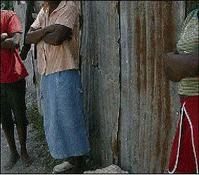
Two adolescent girls and a boy standing outside their place of dwelling in a Kingston inner-city community. In these communities, exposure to crime and violence is high. - Norman Grindley/Deputy Chief Photographer
Exposure to violence at home, school and the community at large, appears to be the sole predictor of delinquency among Jamaican inner-city adolescents, findings from a recent study suggest. The study, completed by students at the University of the West Indies (UWI), sought to identify factors leading to juvenile delinquency among Jamaican adolescents.
Themes of violence and victimisation were most prevalent in the delinquent group surveyed. One 17-year-old male, in response to whether he believed that he would either be stabbed or killed before the age of 20, stated that he strongly believed he would be.
"This was a common response, regardless of gender," stated researchers Stacey N. Brodie-Walker and Kai A.D. Morgan, who surveyed 116 Jamaican adolescent - 55 delinquent and 61 non-delinquent - males and females, between the ages of 14-18.
Their findings were presented at the recent Caribbean Child Research Conference held at the Jamaica Conference Centre in downtown Kingston. The study sought to establish predictors of juvenile delinquency in a sample of Jamaican adolescents. The variables examined were self-esteem, parent-child attachment, and exposure to violence.
According to the researchers, contrary to findings from developed countries, single-parent households in Jamaica are not a significant predictor of aggressive and delin-quent behaviour.
"The relationship between parent-child attachment and delinquency did not yield significant results as hypothesised," the researchers said. "Lack of attachment to parents merely increases the probability that the child will be exposed to criminal influences, that he/she will learn the attitudes, values, and skills conducive to delinquency."
Sample population
The first sample population consisted of 61 Jamaican male and female adolescents who attended several inner-city high schools. Respondents included 18 males and 43 females. The other group, consisted of 55 male and female adolescents who had all been charged for committing a delinquent act. Respondents included 30 males and 25 females. The juvenile delinquent group was selected from remand centres in the Kingston and St. Andrew area. Participants ranged in age from 14 to 18 years, with a mean age of 16.1
Of the three variables examined, only the exposure to violence variable showed a significant relationship with delinquency.
- Avia Collinder

